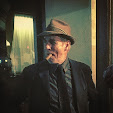It exists
in the clowning world. And the cabaret world. And the circus.
And when
you're doing all three as I have been at Teatro ZinZanni for the last few
months, it exists there too. In spades.
Animation.
I've
talked about it before here.
It's kind
of a super charged version of mingling. It's "working the room" with
intent.
It's
testing the waters, gauging the temperature, getting your feet wet.
It's
stepping on to the killing floor and playing.
It's fun.
You're
not grabbing the whole room and commanding attention. You're subtly
infiltrating across the footlights. You're not drawing attention to yourself.
You're insinuating your character into the atmosphere. You're delicately
infusing some antic spirit onto the proceedings.
You're
basically just moving about psychoanalyzing the audience while you entertain
them.
But
Animation, especially when you're doing "Victim Work" like I am at
ZinZanni, selecting involunteers to join you onstage later on, has an
important purpose. You are vetting future scene partners.
So the
first animation of the evening, before the show officially starts, is perhaps
the most business like. You're touching shoulders, sensing senses of humor,
checking for canes or crutches or accents that might make it difficult if you
cast them later on. A readiness to smile, to laugh, combined with a slight
reticence is usually what I'm looking for.
When a
few of us are doing it concurrently, as we are in the current show Love, Chaos,
Dinner at Teatro ZinZanni, there is a palpable lift in the air, a slight
intensification of the chatter that seems to say: Yes, the fourth wall is down,
this is not television and the lunatics are running this particular asylum.
 |
| Veronin being Veronin. |
Meanwhile
acrobrat Ben Wendell of The Duo Madrona is high five-ing kids as his security
guard character "Bruno". It's not too loud. It's conversational. It
only gets the attention of a darkened booth over here or a table of
bachelorettes there. But sometimes I think that it is the clearest barometer of
what that particular audience's character is going to be.
 |
| Manuela and I at the afterparty. |
Oddiences
They're
all different. They're made up of completely separate and distinct individuals.
But somehow, every night, the combined character of the group congeals into a
single entity, that night- and that night's only- audience. It is the most
talked about subject amongst us back stage.
"How
are they?"
"I
like them."
"They're
a little..."
"I
know, right?"
"They'll
warm up."
"They're
weird."
"It's
an oddience."
For one
of the numbers I'm doing now in ZinZanni, called "East Side Story", a
musical send up of West Side Story which features a dance, a knife fight and a
heart wrenching- and hopefully funnybone tickling- death scene I need an
involunteer to play a Riff/Tybalt inspired gang leader. The bit gets pretty
ridiculous and he quickly becomes an audience favorite and for the rest of the
evening he will most assuredly be getting hearty slaps on the back from his co
workers or extra squeezes from his girlfriend.
But he
doesn't know that yet. He's just a member of the crowd, enjoying the evening.
And I'm probably animating near him- but not with him. I want to see his
reaction when I play with people around him not to him. What you laugh at is a
clear indicator of your personality and I still want a bit of that deer in
headlights look when I pluck him from obscurity later on. It is a very
secretive casting process you are engaged in with one person while you are
being funny with 5 others.
Meanwhile
animation gives you a chance to see each group's pecking order, each families
hierarchy, even each section's level of drunkenness. You gather this
information as you include them in a little conspiracy- a shared intent to not
take ourselves too seriously tonight, suspend our cynicism along with our
disbelief and have some fun.
If you've
been doing it as long as I have you develop some material. Go-to gags that fit
just about any situation. Entendres you can double, compliments you can turn on
a dime, seemingly in the moment observations that I've used before but give a
certain underlying hesitancy to so they seem newly minted.
He Who Is The Most Relaxed, Wins.
He Who Is The Most Relaxed, Wins.
So I
noticed something the other night. I was leaning too heavily on some of these
tried and true tropes. So I let go. Of course there is a level of expectation
as you approach a table. You're in an outlandish costume. Your mustache is
painted on with what looks like a sharpie. But rather than animating at people
I animated with them. I just walked on to the floor and took what came to me. I
just responded in character. In this case mad movie director Cecil B. DeGrille.
And new material came. It always does when you're relaxed. When you replace the
inner monologue that commands you to keep dazzling them with your cleverness
shouting "What do I say next? How can I make this funny?" with a calm
voice that simply says: "Breathe. Listen. Respond."
I was
watching the NBA champion Golden State Warriors on a replay of a game after the
show the other night. I was watching Stephan Curry doing his thing. "Steph
being Steph" they call it. Another spectacular highlight laden
performance. And I was struck by the fact that in the middle of that 94 by 50
hunk of wood, his stage, his killing floor, with all that attention and the
highest level of athleticism and defensive skills in sport pitted against him,
he was clearly the most relaxed player out there. Not pushing to make a clever
pass, not relying on what he knew had worked the last time, not doing anything
by rote. Just breathing, listening, responding.
Sure,
there are gems you hold on to. Stuff you pull from your bag of tricks. But my
favorite moments in animation come when I'm as surprised at what I say as the
patrons are. That we share, in that moment in time, the creation of a new bit.
Then it's up to me to remember it, to hone it and perhaps even add it to my
arsenal. But every situation, every audience is different.





































